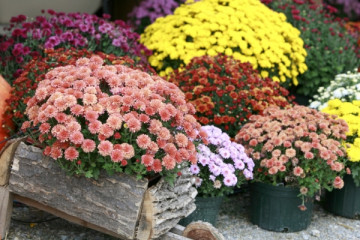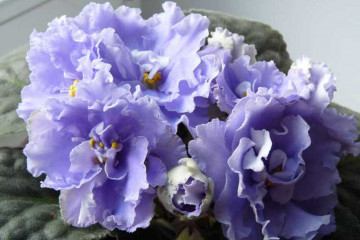Indian chrysanthemum - characteristics of varieties and cultivation from a mixture of seeds
Content:
Among the large number of varieties of chrysanthemums, it is necessary to highlight the Indian one. She is famous for her unusual appearance and undemanding care. It is possible to grow a culture not only for decorating a summer cottage, but also for cutting. If all the features of care are observed, it is possible to obtain a plant with large buds and a long flowering period.
Description of Indian chrysanthemum
Indian chrysanthemum is a perennial plant that has the following description:
- the height of the bush can reach up to 1.5 meters;
- leaves, dissected, green with a matte surface;
- buds in a basket, the color depends on the variety;
- medium-sized buds with a pronounced odor;
- the culture blooms in September and before the first frost;
- roots are underdeveloped, not deep.
Chrysanthemum grows quickly with proper care. However, it can bloom fully only a year after planting.
Briefly about the history of appearance
Chrysanthemum was first cultivated by the Chinese - more than 2500 years ago. The plant was grown as a cooking spice. However, the culture began to spread to other countries from Japan and India.
It was brought to Europe by travelers and received the name Chrysanthemum indicum (small-flowered chrysanthemum). The peculiarity of the plant was the yellow - orange color of the buds. At the moment, there are a large number of varieties of this chrysanthemum, which are obtained by crossing various species.
Beneficial features
The Japanese believed that eating chrysanthemum petals would prolong life. The following useful properties of the plant are highlighted:
- increased appetite;
- reduction of pain in the digestive organs;
- lowers body temperature;
- the leaves are used to treat migraines;
- used to treat Parkinson's disease.
In addition, the plant contains the following medicinal components: essential oil, camphor, choline, adeline, vitamin A.
Common varieties
Chrysanthemum cultivation is a favorite pastime of many gardeners. Indian chrysanthemum is classified into the following popular varieties:
- Aurora - the height of the bush reaches 1 meter. The buds are small, orange. With proper care, the buds can be up to 10 cm in diameter;
- Snow Elf - a feature of the variety is the buds in the form of pompons. Inflorescences are white with a weak aroma;
- Vimini are small yellow buds. The middle is covered with smaller brown petals. A number of large ones are located along the edges;
- Artist - a distinctive feature of the variety is a lush bush. The plant can grow up to 1.5 meters in height. Color mix consisting of pink and white stripes on the petals;
- Leopard - the plant reaches a height of up to 1 meter. The leaves are large, dark green in color. The buds are burgundy, large;
- Fanfare is a small bush. The peculiarity of the culture is the different color of the buds;
- Indian gazelle - bush height up to 1 meter. The buds are large. In diameter, they can reach up to 17 cm.Terry white petals.
Chrysanthemum Indian includes a mixture of different varieties, which differ in individual characteristics and colors of buds.
Planting Indian chrysanthemum seedlings in open ground
It is necessary to plant a chrysanthemum seedling in open ground only after the risk of frost has been reduced. The most preferred period is mid-May. Select a site with a neutral soil type. The site should be well lit by the sun. Otherwise, the growth of bush chrysanthemum will decrease. It is necessary to place the seedling in the ground on a cloudy day.
To do this, perform the following sequence of actions:
- Make a trench up to 40 cm deep.
- Place the seedlings in a trench at a distance of at least 40 cm from each other.
- Sprinkle with soil and compact.
- Drizzle with warm water.
In order for the plant to take root faster, you can add Kornevin to the water. To get a lush bush after planting, it is recommended to pinch the top of the seedling.
Chrysanthemum indicum care
Chrysanthemum indicum does not require complex care. However, following simple rules allows you to get large buds, and extend the flowering period until the first frost.
Watering
You can grow a crop only with proper watering. The plant prefers moist soil, but you should not be too zealous, the accumulation of water leads to rotting of the roots.
In standard weather conditions, watering is recommended every three days. The intensity of irrigation is adjusted by looking at the weather.
Top dressing
It is necessary to grow a crop on a nutritious type of soil. If the necessary substances in the soil are not enough, special fertilizing is used. For this, the following types of fertilizers are chosen:
- during the growth of green mass, nitrogen substances are used;
- during the formation of buds, potash and phosphorus additives are introduced into the soil.
In the fall, before digging for the winter, humus is added, which also acts as a heater.
Pruning
Homemade chrysanthemums require regular pruning. The procedure is carried out in three stages:
- the first stage - at the beginning of summer, the upper part of the bush is cut off. This contributes to the appearance of side shoots;
- the second pruning is carried out in the middle of summer, the tops of the side shoots are cut off;
- the third pruning is done in the fall. The shoots are completely cut off, it is necessary to leave no more than 10 cm above the ground. The procedure is done before sending the bush for the winter.
If not pruned, the bush grows weak and requires a garter.
Transfer
Chrysanthemum does not tolerate frost well, therefore, to preserve the characteristics of the variety, it is necessary to dig out the bush in late autumn. It is necessary to repot the bush in the spring regularly to a new place. This will promote rapid plant development and abundant flowering.
Preparing for winter
One of the main conditions for growing a chrysanthemum is digging it up. Before digging out the bush, it must be properly prepared. In a few weeks, add humus, which will saturate the soil with all the necessary substances. Cut off the bush, and carefully dig out together with a lump of earth. Place the plant in a pot and send it to a cool place.
The most suitable storage place is the basement. The culture is kept there throughout the winter. It is important to follow the rules: water every few weeks and make sure that mold does not form.
Breeding methods of chrysanthemum indicum
The method of reproduction of the culture is chosen by the gardener individually. The seed method and cuttings are used.
Growing from seeds
For reproduction, you must first grow seedlings. The following list of actions is performed:
- At the beginning of March, it is necessary to prepare containers for seedlings and fill them with a nutrient mixture. Ready-made substrate can be used. However, many gardeners prepare their own soil mixture. To do this, mix in equal parts: sod soil, humus and peat.
- The prepared soil must be disinfected with a light manganese solution or exposed to low temperatures (freezing).
- Spread the seeds on top of the ground and sprinkle with warm water using a spray bottle.
- Cover with glass and place on a windowsill.
Seedlings will appear in 2 weeks. In some cases it is recommended to use a fluorescent lamp. Since the seed of the culture is small, the beds are planted densely. After the emergence of seedlings, it is necessary to thin out the beds, leaving stronger specimens.
Rooting cuttings
This method is used very often. For reproduction in early summer, it is necessary to cut the chrysanthemum shoot into cuttings 15 cm long. Place in Kornevin for 2 hours and plant in open ground.
Top with cut plastic bottles. In hot weather, regularly ventilate and care for the cuttings. Observing daily watering. In the fall, transplant the cuttings into a pot and store in a cool place.
Potential growing problems and pests
Chrysanthemum is rarely exposed to disease. However, with improper care, the following problems may arise:
- gray rot - brown spots appear on the leaves and shoots. For treatment, it is necessary to treat the bush with a Bordeaux mixture;
- aphids are one of the most common problems during cultivation. It feeds on plant sap and can lead to its death. To eliminate the pest, it is necessary to process the bush with soapy water;
- the plant does not bloom - this problem can arise with an excessive amount of fertilizer. The bush must be transplanted to a new growth site.
With proper care, diseases and pests do not appear.
Growing chrysanthemums allows you to enjoy the vibrant colors in late autumn. In order for the bush to bloom violently and not be exposed to diseases, it is necessary to water it in a timely manner and introduce nutritious components. Indian chrysanthemum is subdivided into a large number of varieties that have their own individual characteristics and will adorn any garden plot.























